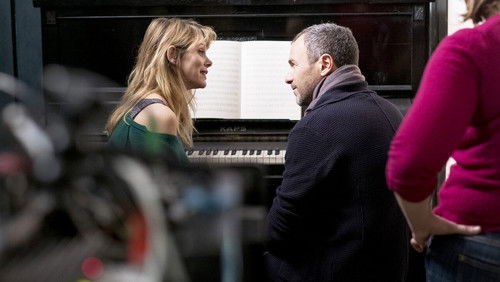Rififi (1955)
57KRififi: Directed by Jules Dassin. With Jean Servais, Carl Möhner, Robert Manuel, Janine Darcey. Four men plan a technically perfect crime, but the human element intervenes…
“Du Rififi Chez Les Hommes/Rififi(1955) can on the surface be described as a French variation on John Hustonu0026#39;s seminal heist film, Asphalt Jungle(1950). The difference between the two films is Rififi(1955) pays a little more attention in detail to the robbery sequence. Also, the police arenu0026#39;t involved in the aftermath of the robbery in Rififi as much as in Asphalt Jungle. In the end Rififi(1955) is in my opinion a slightly better film than Asphalt Jungle(1950). Remarkable Noir picture that defines 1950s French Cinema.u003cbr/u003eu003cbr/u003enSpartacus(1960) may have been the one which broke down the infamous blacklist, but in my opinion Rififi(1955) was the film that began to break apart the unbreakable Hollywood blacklist. First film in five years for Jules Dassin who was victimized by the McCarthy communist hunt of the late 40s to early 50s. He got some sort of retribution when Rififi(1955) became a success around France and Europe. Thus defying the poisonious Hollywood blacklist in a major way that probably inspired others to do the same. Rififi(1955) is the most important film of Dassinu0026#39;s career because it not only restored his name, but also gave him a second chance at making films.u003cbr/u003eu003cbr/u003enJules Dassin gave the filmworld and its ever growing audiences a masterpiece of influential proportions. His handling of the material is exceptional and direction of the actors is flawless. Builds up tense situations with precise craftsmanship. Dassin came full circle in the Film Noir genre by directing his best and last Noir, Rififi(1955). Marked the end of Dassinu0026#39;s period in filmmaking when he was involved in doing Noir pictures.u003cbr/u003eu003cbr/u003enRififi(1955) is the number one film in an arsenal of thirty plus films for director, Jules Dassin. A masterpiece in acting, cinematography, directing, editing, and writing. Not a film to leave your seat for one minute because there is always something memorable going on. As brilliant as anything by Jean Pierre Melville who was a master of this type of film. Masterpieces such as Rififi(1955) are relatively small compared to the probably billions of films made in motion picture history.u003cbr/u003eu003cbr/u003enThe one fascinating aspect of Rififi is the precise planning and careful execution of a robbery that takes up a bulk of the 118 minute duration. The main characters plan and execute the jewel heist in the same way a film director prepares for the pre-productions, production, and post-production of a film. Shows how difficult a Jewel heist like in Rififi(1955) is in committing and why very few would do something like it. The fact that the scene hardly contains a mess up like in other heist films turns this scene into something even greater. Close as one can get to having a perfect sequence in a motion picture.u003cbr/u003eu003cbr/u003enLack of unnatural sound in the landmark thrity minute heist sequence puts it in a realm of absolute realism. Any dialogue or/and music would ruin any suspense and tension the director is trying to create. The use of natural sound makes the heist sequence a rewarding film viewing experience. Now Filmmakers and producers would use dialogue and music in a scene like this because of a lack of confidence of a mainstream filmgoeru0026#39;s patience. Sustains a level of consistency that never once lets down.u003cbr/u003eu003cbr/u003enMaintaining a high level of suspense is what makes the heist sequence tick to perfection. The director achieves suspense in the heist sequence thatu0026#39;s rarely equaled in most robbery scenes from heist films. Jean Servais and the rest of the main actors contribute to the suspense with some low key acting. Getting suspense put in a scene is a task few are capable of doing. The robbery sequence of Rififi(1955) reaches a Hitchcockian level of suspense and tension.u003cbr/u003eu003cbr/u003enMany filmmakers from the years following Du Rififi Chez Les Hommes(1955) have been influenced if not inspired by it. One filmmaker influenced was Jean Pierre Melville(original choice for director of Rififi)who used variations of the heist sequence in Le Doulos(1961), and Le Cercle Rouge(1970). Another filmmaker influenced was Stanley Kubrick who made a similarly themed film in The Killing(1956). Also, Quentin Tarantino whose debut feature Reservoir Dogs(1992) was inspired by this film. Other film directors influenced are John Woo, Michael Mann, Paul Schrader, Ringo Lam, etc…u003cbr/u003eu003cbr/u003enDu Rififi Chez Les Hommes(1955) is comparable to Bob le Flambeur(1955) in many ways. One, Jules Dassin and Jean Pierre Melville directed groundbreaking films in Rififi(1955) and Bob le Flambeur(1955). Two, each film involves an aging criminal who plans and carries out a daring heist. Three, Bob le Flambeur and Rififi finishes in fatalistic fashion. Four, each film shares many motifs and situations that classify the two as film greats.u003cbr/u003eu003cbr/u003enPart of Rififiu0026#39;s charm are the colorful characters that surround the story such as Tony le Stephanois, Jo le Suedois, Mario Farrati, and Cesar le Milanais. Most of the violence is implicit yet effectively brutal. The main characters led by Tony le Stephanois abide by a strong outdated code of honor that is remindful of Sam Peckinpah and John Woo. Jean Servais becomes the role of Tony le Stephanois with his cynical outlook and tired looks. Du Rififi Chez Les Hommes/Rififi(1955) became a favorite of mine the moment I saw it on the big screen from beginning to end.”









